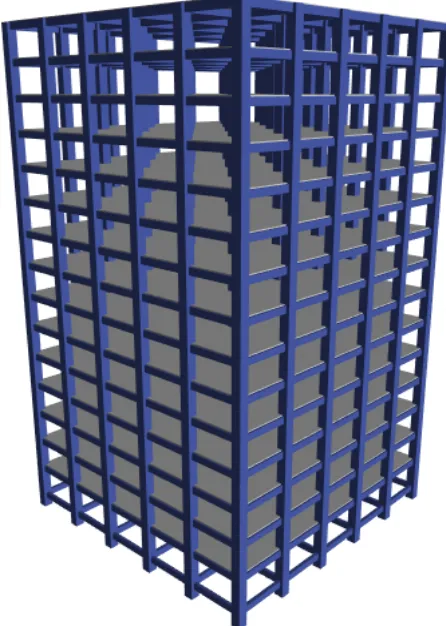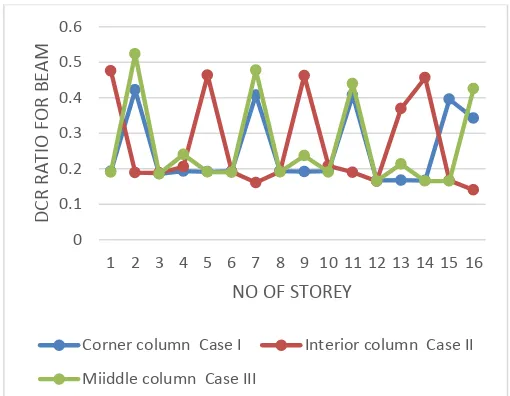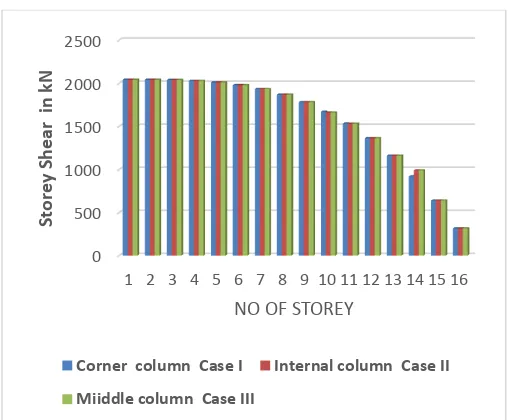© 2017 IJSRST | Volume 3 | Issue 6 | Print ISSN: 2395-6011 | Online ISSN: 2395-602X Themed Section: Science and Technology
Progressive Collapse Analysis of Multi-Storied RCC Building
Yogesh T. Birajdar 1 , Dr. Nagesh L. Shelke2
1
Post Graduate Student, Department of Civil Engineering, DYPSOET, Lohegaon, Pune, Maharastra, India 2
Assistant Professor, Department of Civil Engineering, DYPSOET, Lohegaon, Pune, Maharastra, India
ABSTRACT
The term “Progressive collapse” defined as ultimate failure or proportionality large failure of a portion of structure due to spread of local failure from element to element throughout the structure. I studied previous paper on progressive collapse, they have analyze multistory building and get result of prevention of progressive collapse since the progressive collapse of Ronan point apartment building in 1968 and world trade centre (WTC), and to give idea about constructing building safer from progressive collapse. To use of general service administration guidelines (GSA, 2003) three dimensional (3D) model of building were developed to analyze and compare progressive collapse response by commercially available program ETABS. In number of previous paper multistory building analyze for progressive collapse of linear static and linear dynamic procedure by STAAD pro and ETABS software, they result conclude that comparison of DCR ration in different cases and different column removed cases and also displacement, time period, storey shear are concluded. The objectives of project work is to study various types of progressive collapse and its mechanisms and analyze (G+15) RC earthquake resisting building for seismic zone III as per IS 1983:2002 by using ETABS 2016 software for linear dynamic analysis procedure. Complete the mathematical modeling of multistory building and different types of loading combination and to find out time period, axial forces variation, bending moment variation, DCR for column and beam in different cases, and knowing the response of the structure for progressive collapse by using ETABs software.
Keywords: Progressive Collapse, GSA, DCR, Linear dynamic analysis, ETABS Software, Failure.
I.
INTRODUCTION
1.1 General
Progressive collapse is a consistent destruction of the bearing structures of the building due to the initial local damage to the individual carriers of structural components and leading to the collapse of the entire building or substantial part.
As the small structural element fails, it initiates a chain reaction that causes other structural elements to fail in a major effect, creating a larger and more destructive collapse of the structure. A good example of progressive collapse is a house of cards; if one card falls near the top, it causes multiple cards to fall below it due to the impact of the first card.
Causes of progressive collapse
1) Design or construction Error. 2) Overload due to occupant misuse. 3) Earthquake.
4) Gas explosions. 5) Fire.
6) Bomb explosions.
7) Storage of hazardous materials. 8) Vehicular collision.
9) Aircraft impact. 10) Differential settlement.
collapse.Progressive collapse can be triggered by many different actions. Examples of such actions can be: explosions caused by gas or explosives; impacts of vehicles, ships or planes; earthquakes human errors in the design or construction phase etc. Prediction of such abnormal actions is very difficult and depends on many factors. Designing for example a large frame reinforced concrete building against progressive collapse due to blast loading is a big challenge. Analysing such a building and checking if a progressive collapse could happen or not depends on many assumptions. For example the major unknowns are: how big the explosive charge is (what is the peak pressure), how far from the building the explosive is detonated, and whether the blast affects the corner load-bearing elements of the building or the ones situated in the middle of the building's sides etc.
1.2 Objectives of Work
The objective of this study report is
To understand the whole meaning and typologies of progressive collapse.
To understand the mechanism of progressive collapse.
To study various design approaches as provided by British standards, GSA2003, U.S DOD 20005 & US DOD 2009 standards.
To study the process of progressive collapse analysis of multi-storey (G+15) RCC building by using ETABS 2016 software in different column remove cases.
To understand progressive collapse analysis of building by Linear dynamic analysis.
To check whether a RC building analysis and detailed by Indian codes for seismic loads provides any resistance to Progressive collapse or not.II.
MATHEMATICAL MODELING
The correct analysis will depend upon the proper modeling the behavior of materials, elements and connectivity. Therefore, it is important to select an appropriate and simple model to match the purpose of analysis. In progressive collapse assessment mathematical modeling of the structure is based on earthquake loading because it simulates actual behavior of the structure. For the proposed work,
three-dimensional model is selected. A three-three-dimensional model has independent displacements at each node and can simulate any type of behavior. Fig shows three-dimensional model of a frame considered for analysis.
Figure 1. Three-Dimensional Model of Structure
2.1. Demand Capacity Ratio (DCR)
Demand capacity Ratio is defined as the ratio of the force (bending moment, axial force, shear force) in the structural member after the instantaneous removal of a column to the member capacity.
DCR limit values depending on the cross sectional dimensions and on the construction materials. In DCR, demand indicates the Bending moment of the member obtained from the static analysis of frame and the capacity indicates the ultimate moment resistance capacity of the member i.e. Plastic Moment. DCRs are not used to determine the acceptability of component behavior, but it is used only to determine the structure’s regularity of the building. DCRs for building components are calculated by following Eq.
Mmax: Bending Moment of the member obtained from the analysis
Mp: Expected ultimate moment capacity of the member. (Mp=0.138Fckbd2)
The acceptance criteria for DCR are given below For typical structure (symmetrical structure) = DCR≤ 2.0
For typical structure (unsymmetrical structure) = DCR≤ 1.5
Linear dynamic Analysis
This analysis procedure is simple and easy to perform. However, it is limited to relatively simple structures. Response is evaluated by Demand to Capacity ratios (DCR), which should not exceed a value of 2 which is prescribed code.
III.
PERFORMANCE ANALYSIS AND RESULT
The various models discussed for progressive collapse by performing linear dynamic analysis. the analysis carried out by using software ETABS. ETABS is special purpose computer program. This program proved special feature for all drafting and model generation creation, analysis, designed can access fast and convenient. various results obtained from analysis are presented.
3.1. Variation of DCR Ratio of Column for Different Cases
In different cases remove different columns and get result of DCR ratio value on columns in different stories. Show the graph are given bellow.
Fig. 2 :Graph showing DCR ratio for column in different cases
3.2 Variation of DCR Ratio Of beam For Different Cases
In different cases remove different columns and get result of DCR ratio value on beam in different stories. Show the graph are given bellow.
Fig. 3 :Graph showing DCR ratio for beam in different cases
3.3 Displacement In Different Stories
Linear dynamic analysis is carried here by using ETABS software. A 3-D modeling of building is done first and load are applied as per guidelines. Linear hinges are provided at the end of beams and columns. After that structure is pushed down and vertical displacement occurs at different stories with different cases. Figure
0 0.05 0.1 0.15 0.2 0.25
1 2 3 4 5 6 7 8 9 10 11 12 13 14 15 16
DC
R
RAT
IO
FOR COLUMN
NO OF STOREY
Corner column Case I Internal column Case II
Miiddle column Case III
0 0.1 0.2 0.3 0.4 0.5 0.6
1 2 3 4 5 6 7 8 9 10 11 12 13 14 15 16
DC
R
RAT
IO
FOR BE
AM
NO OF STOREY
Corner column Case I Interior column Case II
shows graphical representation of displacement and number of stories at different column remove cases are given below.
Fig. 3 :Graph showing displacement in different stories
3.4 Storey Shear Of Building In Different Stories
In different cases remove different columns and get result of storey shear value in different stories. Show the graph are given bellow.
Fig. 4 :Graph showing storey shear in different cases
3.5 Time Period In Different Cases
In different cases remove different columns and get result of time period variations in different stories. Show the graph are given bellow.
Fig. 5 : Graph showing time period in different cases
IV.
CONCLUSIN
In the present work, linear dynamic analysis of RC earthquake resistant building is carried out by using commercial software ETABS 2016. Vulnerability of building against progressive collapse is studied and the conclusion are drawn from the analysis are discussed below.
1. Linear dynamic analysis procedures for progressive collapse determinations, if modeled using initial conditions methodology, are simple to perform by practicing engineer through computer program. 2. In case II LDA of RC frame with removal of column
C26 (intermediate column) has highest DCR (0.474) value.
3. DCR ratio value of beam are more as compare to DCR ratio value of column.
4. For LDA all column is safe with DCR value less than < 2 i.e. GSA criteria.
5. To avoid the progressive failure of the beam and column, caused by failure of particular column, adequate reinforcement is required to limit the DCR within the acceptance criteria.
6. Among three cases of column removal, most damaging collapse occurs when interior column is lost, next is corner column failure, finally middle column failure.
7. Increasing beam size will be more effective in avoiding or delaying collapse rather than increasing column sizes.
0 5 10 15 20 25
1 2 3 4 5 6 7 8 9 10 11 12 13 14 15 16
Dis
p
lace
m
en
t
in
mm
No. of Storey
Corner column Case I Internal column Case II
Miiddle column Case III
0 500 1000 1500 2000 2500
1 2 3 4 5 6 7 8 9 10 11 12 13 14 15 16
Sto
re
y Sh
e
ar
i
n
k
N
NO OF STOREY
Corner column Case I Internal column Case II
Miiddle column Case III
0 0.5 1 1.5 2
1 2 3 4 5 6 7 8 9 10 11 12 13 14 15
Tim
e
Peri
o
d
in
se
c
NO of Mode
Corner column Case I Internal column Case II
8. The size, shape, and importance of the building are major factors used to determine the most suitable analysis approach for each building.
9. To prevent progressive collapse, the structural system of the building should be able to tolerate the removal of one or more structural member and redistribute their load on the surrounding member, so that disproportionate collapse would not take place.
10. The displacement of storey increases with number of storey increases.
11. The time period of storey decreases with number of storey increases.
12. Storey shear decreases with number of storey increases.
V.
RECOMMENDATIONS AND FUTURE SCOPE
In this work, only concrete frame structures were analyzed to investigate vulnerability of the building to progressive collapse. It would be interesting to investigation to evaluate the progressive collapse potential of other building with different structural system and configuration, Such as steel-frame structures and a typical structural configurations.
There are four types of analysis method that may be used in the assessment of the potential for progressive collapse: linear static analysis, linear dynamic analysis, nonlinear static analysis, and nonlinear dynamic analysis. In this work, linear dynamic were conducted using ETAB computer program. It is also expected that which analysis can prove the most accurate and suitable method to analysis the progressive collapse vulnerability of the building.
Steel building can also be studied for evaluation of progressive collapse.
Higher storey building can be studied with dynamic analysis for progressive collapse.
Building can be analyzed for blast load by time history analysis method to know behavior of structure.
Investigation failure of column located in floors other than the ground level, for example in the middle level storey.
Measures to reduced progressive collapse like providing bracing system at lower storey.VI.
REFERENCES
[1]. Starossek, U., "Progressive collapse study of a multi-span bridge," IABSE, Structural Engineering International, Vol. 9, No. 2, 1999, pp. 121-125.
[2]. GSA, "Progressive Collapse Analysis and Design Guidelines for New Fed¬eral Office Buildings and Major Modernization Projects’’, General Ser¬vices Administration (GSA), Washing¬ton, D.C., 2003.
[3]. Wearne, P., "Collapse—When Buildings Fall Down," ISBN 1-57500-144-6, New York, TV Books, L.L.C., 2000.
[4]. Wittfoht, H., "Ursachen für den Teil-Einsturz des `Viadotto Cannavino´ bei Agro di Celico," Beton- und Stahlbetonbau, Vol. 78, No. 2, 1983 (in German).
[5]. AISC, Manual of Steel Construction, 6th Edition, American Institute of Steel Construction (AIST), 1969.
[6]. Sasani, M. and Serkan, S., 2008. "Pro¬gressive Collapse Resistance of Hotel San Diego," Journal of Structural En¬gineering. ASCE V. 134, No. 3, March 2008. Pp. 478-488.
[7]. Sezen, H. and Brian, S.,2008. "Pro¬gressive Collapse Analysis of the Ohio Union Steel Frame Building." Euro¬Steel 2008. V. 3, No.5 2008. [8]. Wei-Jian Yi, et al ,( 4, July-August
2008).Experimental Study on Progressive Collapse-Resistant Behavior of Reinforced Concrete Frame Structures. ACI STRUCTURAL JOURNAL,V. 105, No.
[9]. General Services Administration.( Nov. 2003). Progressive Collapse Analysis and Design Guidelines for New Federal Office Buildings and Major Modernization Projects, U.S.A.
[10]. American Concrete Institute. (1999), Building code Requirements for Structural Concrete (ACI 318-99) and Commentary (ACI 318R-99), Farmington Hills, U.S.A.
Engineering International, Vol.16, No. 2, May 2006.
[12]. UFC, "United Facilities Criteria—Design of Buildings to Resist Progressive Collapse," U.S. Department of Defense, UFC 4-023-03, January 2005.
[13]. Ellingwood, B. R., and Dusenberry, D. O., "Building design for abnormal loads and progressive collapse," Computer-Aided Civil and Infrastructure Engineering, Vol. 20, No. 3, 2005, pp. 194-205.
[14]. Progressive Collapse Analysis by GSA and UFC criteria. "UFC 4-023-03, Design of Structures to Resist Progressive Collapse’’, Dated 25 January, 2005
[15]. Miss. Preeti K. Morey, Satone S. R.,"International Journal of Engineering Research and Applications" (IJERA) ISSN: 2248-9622 Vol. 2, Issue 4, June-July 2012, pp.742-745.
[16]. J.M. Russell, J.S. Owen and I. Hajirasouliha, "Experimenta investigation on the dynamic response of RC flat slabs after a sudden column loss",Engineering Structures, 99


